Wedding Chests in Renaissance Florence: An Introduction to Cassoni Panels
Plus, think of your own love-related material culture to join The Vivid Eye's first live chat! Keep a lookout for a detail of Cupid balancing on a gold cheeseball.

Today I continue the Triumph of Love theme from my last post, to bring you the subjects painted on wedding chests, called cassoni (singular, cassone). Cassoni began as painted storage boxes for linens and clothing from early 15th century Italy, a part of what the material culture—that is, the objects people lived with, aesthetically and/or practically—of the quattrocento. The paintings on these cassoni would become foundational to the flourishing artistry of the Italian Renaissance. With secular or secularized themes, and a rectangular format as an arena for pictorial play (such as trying out perspectival space), cassoni helped spark Renaissance artistic developments and the characteristics that we still think of as defining paintings today. And they are still commonly found in museums—see if your local art museum has one!
You, dear reader, could probably name some items of wedding-related material culture from your current or past lived experience. Perhaps you or your friends display a ketubah (a Jewish wedding contract), or have a framed invitation or wedding photos on the walls. Perhaps your grandmother sewed a wedding quilt with her community or had a “hope chest” where she kept her linens. That age of “hope chests,” wooden boxes where a girl collected her embroidered linens for her future, hoped-for wedding, has faded from widespread use but was still strong in midcentury America.

I have some embroidered pillowcases from my late mother-in-law’s girlhood. Her mother kept her girls busy and “out of trouble” in their teens by making them finish cross-stitch projects, including an entire king-sized quilt, that my co-parent still has. That is a LOT of little x’s. She eventually rebelled by getting her PhD in Russian History. I want to hear about the material culture in your homes, if you want to share or discuss some! so I’ll be hosting a chat sometime in March on Substack. Make sure to subscribe so you don’t miss the date and time announcement!

So, what is a cassone? Giorgio Vasari, an artist working in 16th century Florence who is more famous for writing about the lives of other artists—the first art historian!—described the quattrocento cassoni as “great wooden chests in the form of a sarcophagus, with the covers shaped in various fashions, and there were none that did not have the said chests painted; and besides the stories that were wrought on the front and on the ends, they used to have the arms, or rather, insignia of their houses painted on the corners, and sometimes elsewhere. And the stories that were wrought on the front were for the most part fables taken from Ovid and from other pets, or rather, stories related by the Greek and latin historians, and likewise chases, jousts, tales of love, and other similar subjects, according to each man’s particular pleasure. Then the inside was lined with cloth or with silk, according to the rank and means of those who had them made, for the better preservation of silk garments and other precious things”. Many of the chests and other furniture in the apartments of the Florentine aristocracy “were painted—by the hand, not of common painters, but of excellent masters, and with judgement, invention, and marvelous art…Of such things relics are still seen, not only in the palace and the old houses of the Medici, but in all the most noble houses in Florence.”*
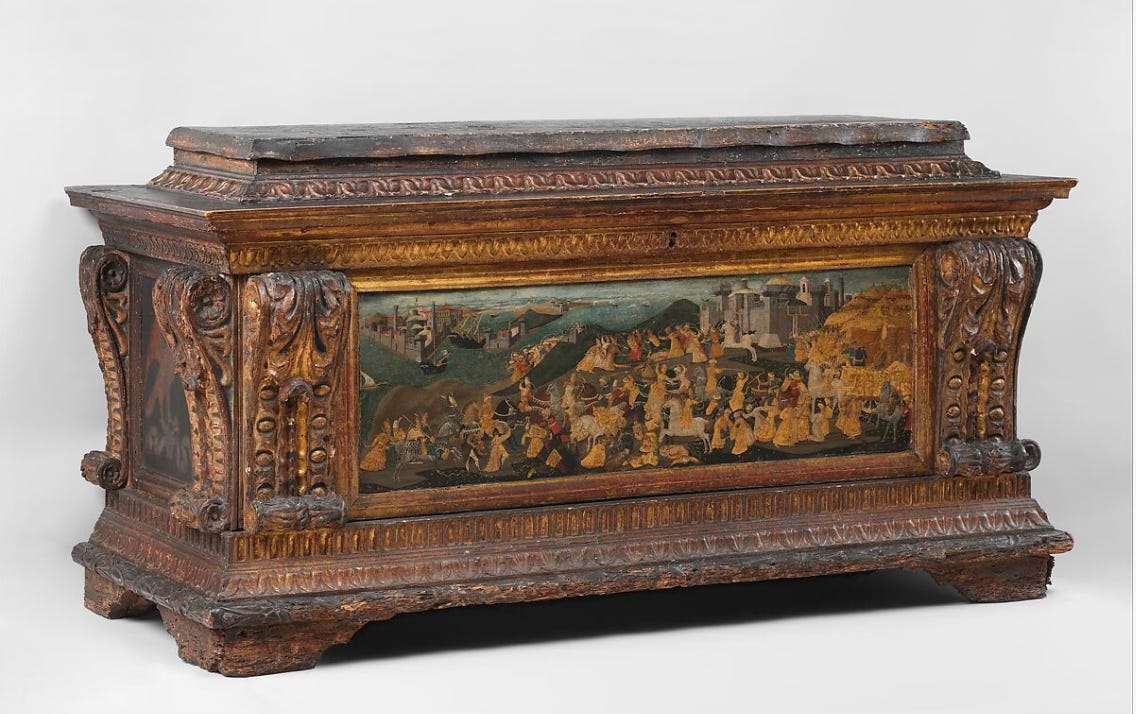
To sum up: cassoni were painted with family heraldry and symbols, made to order, and generally had a secular or classical poetic subject, often involving love. This makes sense, since cassoni were made as part of the celebration of the joining of families in marriage. They were private commissions—not ordered by religious or state institutions—so this makes cassoni painting a relatively new Renaissance phenomenon, and artists had more freedom to interpret subjects that didn’t have a lot of precedents, such as the Triumph of Love. I think this is why cassoni painting contributed to the rise in status of artists in Renaissance Italy, since the format provided a space for experimentation, attracting the most talented artists in Florence, as Vasari noted. Some of the artists fulfilling orders for cassoni included Masaccio, Paolo Uccello, and Apollonio di Giovanni. I also think it notable that Vasari compared the shape to a sarcophagus—not because of a connection to death, but because Roman sarcophagi were among the most prevalent and available Roman artworks for Renaissance artists to study.
The Triumph of Love theme, based on Roman triumphal precedents, found itself perfectly positioned in the center of the Venn diagram of all these interests and fashions in early 15th century Florence, and the long format of the front panel on the cassone was good for including a litany of characters in procession—indeed, there was enough room to squeeze in more Triumphs from Petrarch (described in my last post). The cassoni at the top of this post were created as a pair, to feature all six of the Triumphs. It was common to commission two, maybe so they could have one for the bride and one for the groom—his/hers sets!
On the wedding day, the aristocratic families would parade through the streets of Florence, and the wedding chest itself would have been part of the wedding procession— a way to showcase the family’s wealth, briefly, before it was positioned in the bedroom. In a way, the two families enacted their own Triumph of —if not love, then a really great arrangement that was surely already flowering into Love. (We don’t have records about what the young bride and groom thought about each other. One only has to think of Romeo and Juliet to remember that the arranged marriage idea between families, not young love, was the norm in aristocratic Renaissance circles, tragically in their case.) Thus a procession made a perfect subject for the cassone decoration, mirroring an idealized societal gathering.
A good example is the Triumph of Love and Triumph of Chastity cassone panel now in the national Gallery of Edinburgh in Scotland, which fits both the Triumphs in a single panel, connecting them by having the same Cupid, with his gold and spangled wings, bound to a red column on Chastity’s carriage. As in the many illustrations after Petrarch’s poem, the Love’s carriage is pulled by four whiter-than-snow horses and Chastity’s carriage, showing love bound but not destroyed, pulled by two unicorns.

This cassone is attributed to the workshop of Apollonio de Giovanni, working with Marco del Buono Giamberti; these artists specialized in furniture painting as well as deschi da parto (birth trays, which I will cover very soon) and especially manuscript illumination. They would have known the illustrations after Petrarch, and in this image we can tell their flair for detail and precious finery in the costumes of gold and the many fashionably bulbous hats. Even though he fills the scene with people, as Petrarch describes in the Triumph of Love, we cannot recognize them by their costumes (where is Jupiter? Hercules? Samson? etc.) because they all look like Florentine aristocrats at the height of fashion, with gold and patterned robes, fur-lined tunics, pied hose, and those elegantly impractical hats. It reflected, at least aspirationally, the aristocratic patrons of this cassone. By including a Triumph of Chastity, with more demure but still desirably elegant women, the artists could also provide moral aspirations for the newlyweds—keep Love alive, yet bound within your marriage.






The two scenes are divided by a tree and a rocky mini-hill, and the appearance of the same Cupid twice is an instance of continuous narration, (see my post on the later Sacrifice of Abraham by Ugo da Carpi after Titian for definitions and discussion). Like a manuscript, this cassone panel is read from left to right, rather than the perhaps more logical way of Chastity following Love, the order in Petrarch’s poem.
The commissioning of cassoni such as this would have provided employment for a range of craftsman in the early quattrocento, not just the artist who would have designed and painted the composition, but of course carpenters and furniture joiners, a specialist in applying gold leaf over a ground called red bole, and someone literate enough to know the triumphs of Petrarch. By this time it could have been the artist himself, but literary humanist advisors were becoming part of the courts of the Italian city states, providing artists with subject matter on esoteric Humanist themes. And although the artists here do not match the Roman triumph ritual underpinning the Triumph of Love with all’antica (“antique-style”) costuming, I do wonder if they quote the Belvedere Torso in that figure of Cupid bound. If so, this is the earliest quotation I know—of approximately a zillion—of that famous sculptural fragment that Michelangelo and other later artists quoted liberally. It was known in Rome certainly by the 1430’s, so it’s possible! Tell me if you think it’s a quote (Love is jacked and twisting just like the Torso), or just a coincidence (he’s just tied up, anyone would engage their core in a bend like that), in the comments.



There are scores of these cassoni panels that survive, and while most of them have themes from antiquity or secular poetry, I did find one by Apollonio di Giovanni that secularizes the biblical story of Solomon meeting the Queen of Sheba. It’s a fitting adaptation for an object that brings two families together for a wedding. This one plays with a complex perspectival architecture in the central space, with the crowds on two sides dressed in their fashionable finery, with elements of the Renaissance court such as a dwarf, horses, and hunting dogs.



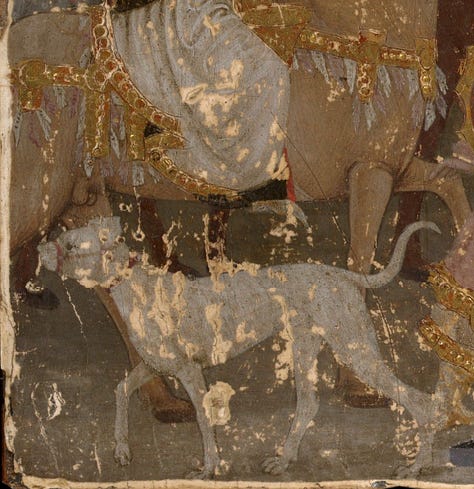

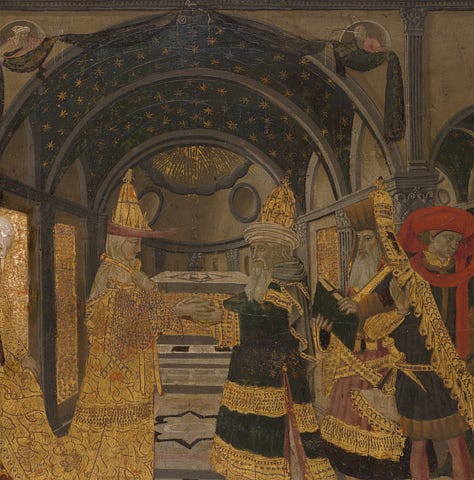
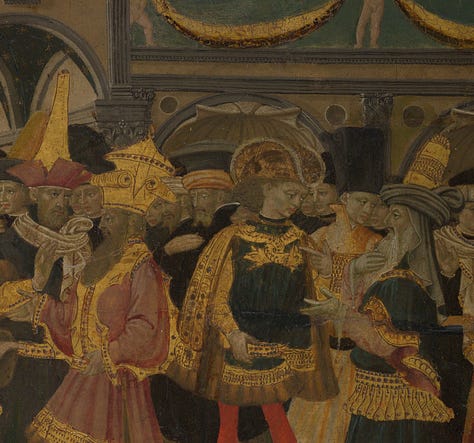
So far I’m showing you just the front panels of these cassoni. These survived by being cut out of the box, framed, and hung on the wall, which was easier to sell and display than an enormous wooden box. If you were a 19th century art dealer, that meant you could sell more than one painting out of them! But originally, when you opened the lid of the cassone, there could be another surprise painting—something only appropriate in the bedroom—oh la la!
That will be the subject of the next post, but for now, I’ll leave you with a view of how the cassoni panels at the top of this post are currently displayed in the Isabella Stewart Gardner Museum in Boston:
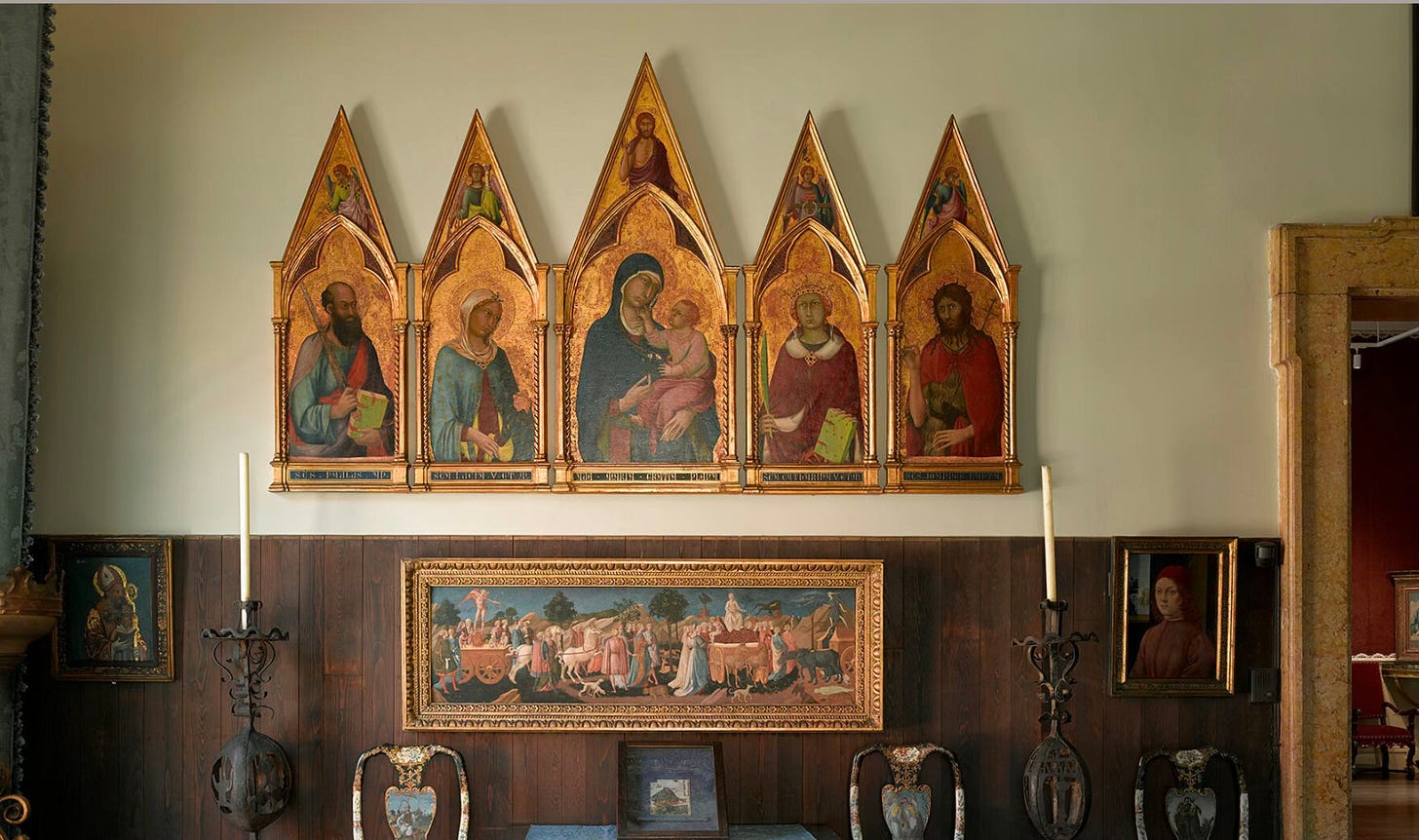
I covered a lot here, so if you have any questions or are curious about learning more—let me know in the comments, or catch me in the chat next month!
*Vasari quote found in Andrea Bayer, ed. Art and Love in Renaissance Italy, Metropolitan Museum of Art, Yale University Press, New Haven and London, 2008, p. 64-65.




